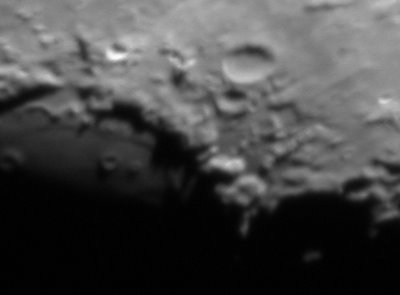17 day 4 hour moon from the Statues
Session name: 20061207.2200
This session was a cold one.
After the seminar, I returned home under a bright, clear moonlit sky. I decided to have a quick photo and observing session nearby at the Statues. Not thinking it was so bad weather-wise I didn't bundle up. I even asked the wife if it was cold and she replied, "You just came in..." Arissa said it was cold. I could have heeded advice from that statement. Not.
This time I set up on the western side of the park entrance at the Statues. Instead of that nasty smel on the eastern side, I could smell funny cigarettes burning - ya know "mary jane". It was on more than one occasion I smelled it but never figured out from where it came. To get a clear shot of Moon over the treetops I set up right on the curb of the sidewalk. Funny enough not many persons stopped by mainly because there was not that much pedestrian traffic.
Altogether there may have been half dozen that stopped by. One young guy, Anthony, stopped by just after two English tourists took interest in the photo setup. Thinking that they would like to look through the eyepiece I removed and replaced the camera with both low and medium power eyepieces. I think they all gotta kick out of it. While there a drunk guy left his nearby party to deliver the punchline: "Do you see Uranus?". And if that wasn't enough, his drunk friend, shouted from a distance with the more original: "Do you see Uranus?" Let's have a drumroll and cymbal crash, please. After that a few individuals and a couple of couples would stop by.
Seeing was not good causing boiling along the moon's limb and the wind caused some shake. The boiling along the limb can be seen in the photo as a soft edge. Regardless, Moon was fantastic and I continue to be impressed by what the hobbyist/amateur can accomplish these days. Even the few pedestrians that stopped remarked about how incredible the moon looked in the tiny lcd.
The photo below is a mosiac of three photos showing most of the 17 day 4 hour waning gibbous moon - it's obvious. I fooled with levels to get the midtones to agree with the upper right photo where the terminator crosses into Moon's southeast quadrant.It is also a lesson in field rotation. Since my equatorial mount was not exactly aligned a small error from north is introduced. This becomes very evident when try to overlap features in GIMP.
Crater Tycho is one the youngest craters, the evidence radiates from the
crater extending across the lunar disk as ejecta material from the impact. If there were younger craters of the magnitude they would have covered the ejecta material. The material closest to the crater rim is material from deep within and the ejecta to the far reaches was closer to the surface.
The other large ray crater Copernicus is seen on the edge of the top and right panel. Its diameter spans 58 miles with a rim that betters a half of mile. When its near the terminator the ray system is less pronounced and one can see the multiple peaks, which rise as high as 3/4 of a mile, and slumping walls more clearly. Ray crater Kepler is the smallest of these three landmarks seen
The second photo below is not a nice, sharp photo at all. But it doesn't lack in information and it validates the notes and sketches I recorded in my log book. What attracted my attention were the ridges that ran concentric with the outer wall. In the eyepiece, I could see the shadow which revealed the dorsae presence. The shadows shows softly above the larger crater on Mare Crisium's floor. The shadow cast by Dorsum Termier was almost as strong as that cast by Rupes Recta. The larger crater on the mare floor (on the left edge of the photo) is Picard (23km) and to the right are two smaller ones: Peirce (18.5km) and Swift (11km). It was much more clear looking through the eyepiece than what the camera shows. To the north Dorsum Oppel is seen just outside of the twin, smaller craters mentioned above.
The capes of Lavinum and Olivium open the western rim allowing sunlight to continue pouring in. As night falls across Crisium features on the floor becoming increasingly more evident with dramatic, sharp shadows cutting in from the west.
Crater Cleomedes has fallen over the horizon into darkness, only its central peak strains to catch photons from the Sun.



<< Home